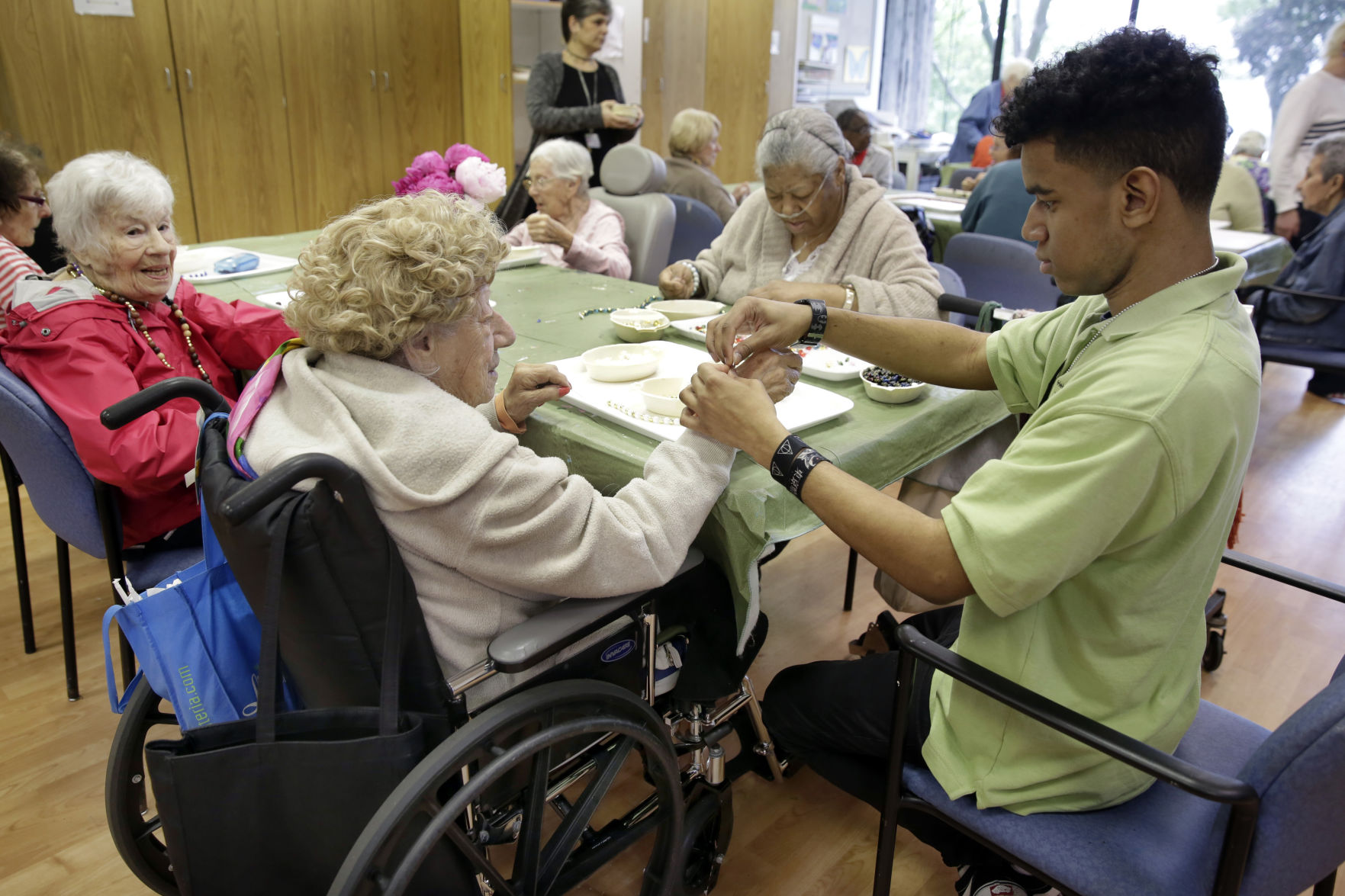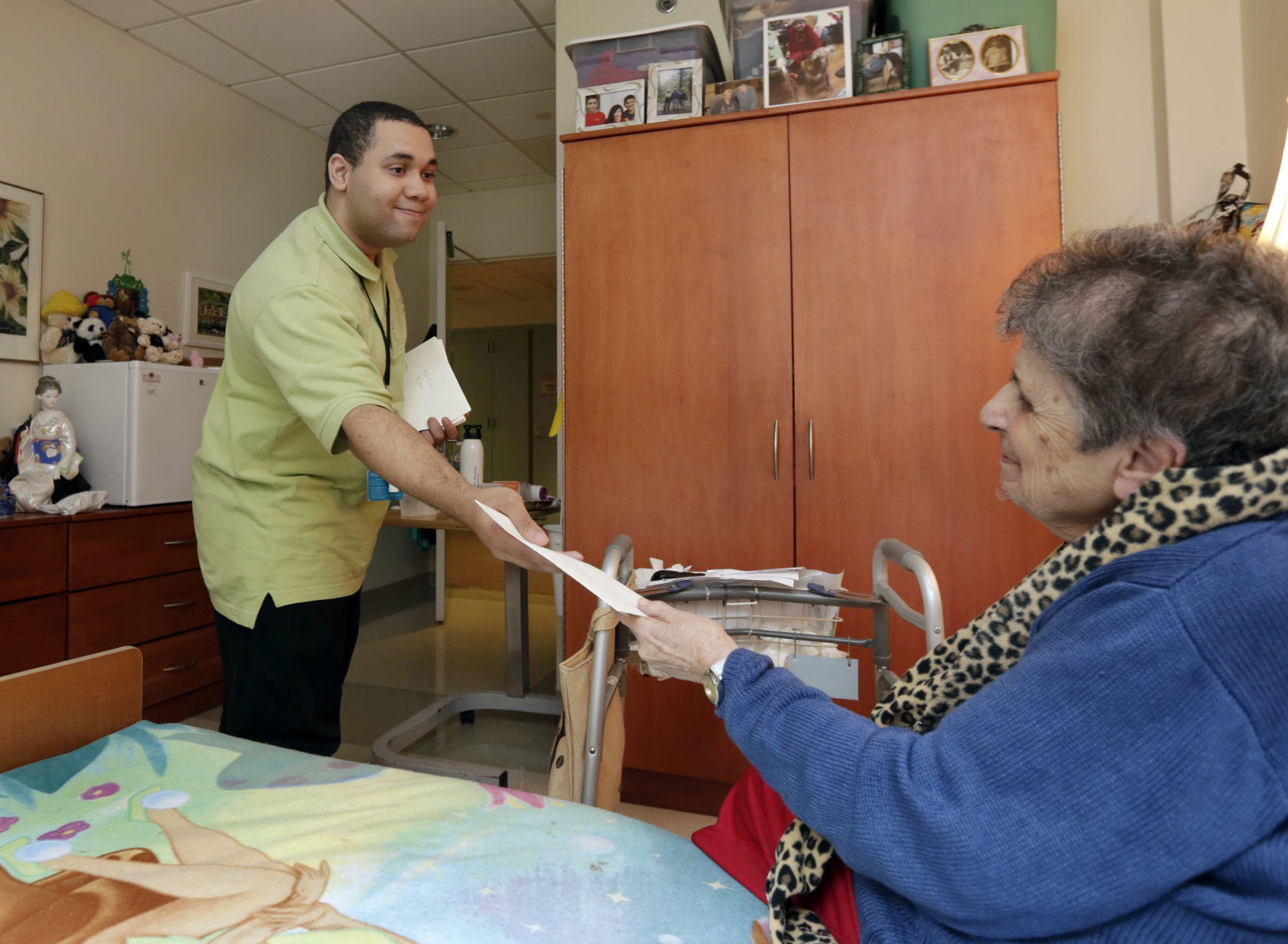A nursing home’s high school teaches lessons on life
NEW YORK (AP) — In a classroom, an old man glides in pushing a walker, and none of the young faces turn. In the cafeteria, a white-haired woman eats across from a teenager, to no one’s surprise. And walking to the school bus, students pass wheelchairs and oxygen tanks as nonchalantly as if they were backpacks and notebooks.
The Hebrew Home at Riverdale, a nursing home on a picturesque stretch of the Hudson River in the Bronx, has gone beyond its calling as a house for the old, playing host to the young with an innovative public high school right within its walls. The students, all of whom have learning disabilities, get vocational training to prepare them for a job at the home or elsewhere, all in the peculiar setting of a school where the old far outnumber the young.
“It’s as though they have 840 grandparents keeping an eye on them every day,” said Daniel Reingold, CEO of the Hebrew Home and the school’s founder.
Reingold started the program around 1995 to address a pair of problems — the difficulty in filling entry-level positions at the home and a “lost generation” of young people born to drug-addicted mothers during the crack cocaine epidemic in the 1980s. After about a decade, the program — called HOPE, for health care offers permanent employment — shifted focus to students with autism and intellectual disabilities, a population Reingold sees as akin to the home’s residents.
“They are both isolated,” he said. “Older adults in this country are isolated, and young people with learning disabilities can be isolated.”
The school day begins like any other, with morning-weary students filing off yellow buses into a cafeteria where they eat egg-and-cheese sandwiches and sip apple juice. Twelve students, all wearing pale green polo shirts with the HOPE logo affixed, await the start of the day’s schedule, when any signs of this being a normal high school fade away. With the prodding of their teacher, Nick Kinas, they shuffle off to work assignments across this sprawling complex.
Indeasia Watson, 21, settles into a nurse’s station, keying data into a computer before being sent on an errand to a downstairs lab. She picks up lancets and diabetic strips, balancing a stack of small cartons between her hands and chin as she passes women in wheelchairs preparing for a music therapy class.
For some students — including Watson, who says she will aim for a clerical job after graduating — the school inspires them to consider for the first time what career they might pursue. For others, their experience at the Hebrew Home may be guided by their stated interests. A girl who likes doing hair and nails works answering phones at the home’s beauty parlor; a boy who dreams of working as a graphic designer helps in the home’s art studio.
Keith Brown, 20, recalls not wanting to start at the Hebrew Home, nervous about its size and unfamiliarity. Two years later, he’s a fixture, squeezing his tall frame into a supply room where he stores shipments of cups, straws and nebulizer medications, then off to a trash room loading empty boxes into a compactor.
Brown completed training needed to allow him to skip the school bus and take the subway and public bus himself, an hour each way from his home in Harlem. That qualified him to apply for a paid job at the home; he was hired for a weekend position pushing wheelchair-bound residents to appointments and activities.
“I was shocked!” a beaming Brown said of his hiring, as he awaited his first paycheck.
Students must be able to communicate to take part in the program, and the home targets candidates who exhibit independence and compassion. Because dealing with change can be especially challenging for learning-disabled students, the school specifically imposes shifting work assignments to help them develop the coping skills they may need to later hold a job. Participants generally are placed from the nearby special-education Public School 721X, with the goal to provide enough training that they can pursue jobs at the nursing home, Jacobi Medical Center or Montefiore Medical Center, which also host students, or elsewhere.
Though work assignments account for the bulk of the school day, students also attend class and have independent tutoring sessions. The classes largely focus on real-world skills and some of the intricacies of working in a nursing home.
One morning, the class gathers around a round table in the nursing home’s library, talking about personal finances and the difference between budgeting for “wants” and “needs.” Off to one side, the home’s bingo equipment is stowed; next door, a chair yoga class is under way; and through one door, a resident with a walker drifts in to peruse the nonfiction racks and spreads of newspapers and magazines. Another day, the students discuss the importance of proper body language and tone of voice, the cognitive declines some of their elders might be experiencing and dots on resident ID badges that indicate a swallowing problem.
“What does DNR mean?” Kinas asks. “Does it mean do not run? No, it means do not resuscitate.”
A decade ago, Kinas was clocking 16-hour days on Wall Street as a portfolio manager and trader when he sought more meaning in his work. He went back to school for a master’s in special education, teaching high school math and science for six years before arriving at the Hebrew Home two years ago. The career change has amounted to a “rebirth” for him, the 58-year-old says, emphatic about how rewarding it feels to help prepare these young people for the world.
“These kids saved me in a lot of ways,” he says. “They’ve taught me as much as I’ve taught them.”
The school aims for a similar interchange between the students and residents. The high schoolers share favorite rock and hip-hop songs, and the elders offer hits from the 1940s and 1950s. Students show residents their smartphones and play music videos and anime on YouTube, the residents in turn share stories from their long lives, including one centenarian who shared childhood memories of horse-drawn buggies with his young audience.
“It’s a history lesson,” Kinas says, “but it’s a history lesson from someone who’s living and breathing.”
There are life lessons, too. Death is a nursing home mainstay and when the students notice a resident is gone, it forces them to talk about it and process the loss. Channel Reid, who graduated from the HOPE program 12 years ago and now works in the cafeteria, still remembers the first time a favorite resident died.
“They believe in you, they give you this love,” she said. “Some of them are just so sweet it’s hard to not be attached to them.”
That tenderness is on display as 90-year-old Selma Bachner sits in a window-lined corner, with a view of birds hopping tree branches and a haze of fog along the Hudson shoreline, with the George Washington Bridge poking out in the distance. She is awaiting her student, 19-year-old Louie Garcia, whom she works with on reading, helping when he stumbles on a word and cajoling him as he answers a workbook’s comprehension questions.
“It makes me feel darn good to help a young person,” Bachner says.
For all the uniqueness of the school, its students are hard-pressed to recognize its singularity, simply seeing it as their daily routine as other schools before it were. At lunch, they munch on honey barbecue chips and pop headphones in their ears or tap away on their phones, and as they await the arrival of buses to take them home at dismissal, they cluster near an exit giggling. Reminders of how different the school really is are constant, though, from a classroom discussion led by Kinas touching on the loneliness and sadness some feel as they grow old to the longer-term experience of residents’ growing medical needs.
Garcia winds through the home’s hallways, delivering mail to seniors one afternoon after his tutoring session, a job he’s been doing for several months and which has sparked his interest in working for the Postal Service when he’s done with school. He knows, looking at those he passes, that he too will grow old one day, that he may have trouble walking or breathing or all the other problems on display before him. It’s just a fact of life, he says.
“If I picture it in my mind,” he said of old age, “I’ll be like all the other residents.”
———
Sedensky can be reached at msedensky@ap.org or https://twitter.com/sedensky




